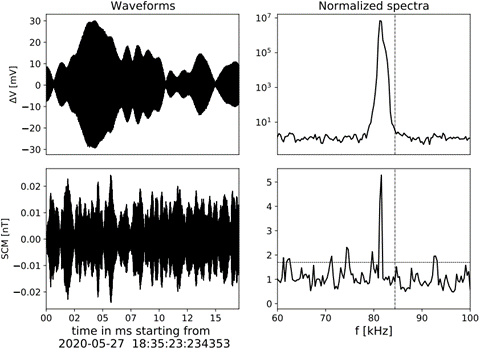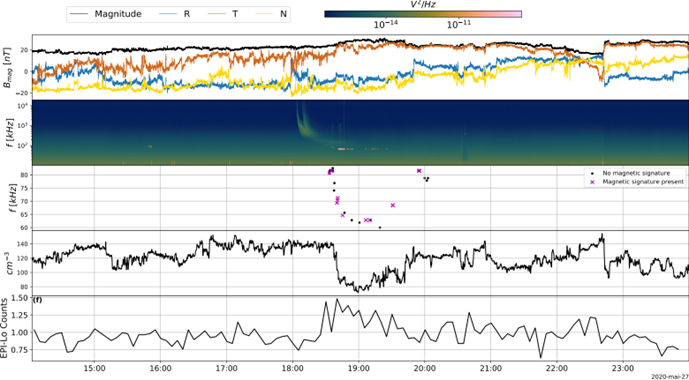Langmuir-Slow extraordinary mode (L-SE) waves have been routinely observed in the Solar wind and in Earth’s electron foreshock since the early age of the space exploration. They are intimately connected to the plasma emission mechanism for the type III and type II radio emissions. In fact, the generally accepted scenario is that L-SE waves are mode-converted to freely propagating electromagnetic emission at the plasma frequency. However, the details of the the mode conversion are debated. A magnetic component for the L-SE was expected from the polarization properties of the electric field, but never measured until recently by the Parker Solar Probe (see Figure 1).

Figure 1. First observation of a magnetic signature in a L-SE wave. On the left, from top to bottom: waveform of the potential difference of the PSP antennas 1 and 2; waveform of the search-coil magnetometer high frequency coil. On the right, their corresponding normalized power spectral densities. The vertical dashed line indicates the location of the plasma frequency as evaluated from the thermal noise data. (from Larosa et al, 2022)
The rare magnetic signatures were observed in a really inhomogeneous plasma environment and were preceded by a type III radio burst. The events were also associated with strong electric fields. An electron beam was present as expected (see Figure 2.)
The link between the magnetic signature, the electric field and the refractive index of the waves can be obtained from the linearized Vlasov-Maxwell system as shown in reference 1. In the Fourier space, the amplitude of the magnetic part of the L-SE is found to be directly proportional to the amplitude of the electric field and inversely proportional to the refractive index. Therefore, a drop in the refractive index increases the magnitude of the the magnetic part of the waves and enhances the chance of observing it above the noise level. The refractive index reach its minimum value when the waves gets reflected due to density inhomogeneities (see reference 1).
The reflections of the Langmuir waves due to density fluctuations can lead to the transformation of electrostatic to electromagnetic energy and explain the formation of type III bursts (see reference 3). Therefore, the observations of the magnetic signatures of the Langmuir-Slow Extraordinary Modes and their link to the density fluctuations are extremely relevant to the plasma emission problem. The mechanisms of transformation of electrostatic waves onto SE and Ordinary waves are both related to the density fluctuations.

Figure 2. General view of the plasma conditions on May 27, 2020. From top to bottom: the magnetic field from MAG; spectrogram of the V1-V2 dipole voltage from RFS (with color-bar at the top); peak frequency of the L-SE bursts observed by TDS; energetic electron counts from EPI-Lo. All the acronyms refer to Parker Solar Probe instruments. (from Larosa et al, 2022)
Conclusions
The first ever unambiguous magnetic signatures of the beam generated Langumir-Slow Extraordinary modes have been observed by Parker Solar Probe. The density fluctuations play undoubtedly an important role in this phenomenon but a key element that is missing here are the details of the beam plasma interaction and how the energy of the beam can effect the observations. Indications of this effect can be found in reference 2. A natural next step is the study of the interactions by means of Vlasov-Maxwell simulations.
Based on a recent paper: Larosa, A., et al., Langmuir-Slow Extraordinary Mode Magnetic Signature Observations with Parker Solar Probe, 2022, ApJ, 95. DOI:10.3847/1538-4357/ac4e85
References:
- Larosa, A., Dudok de Wit, T., Krasnoselskikh, et al. 2022, ApJ, 95.https://ui.adsabs.harvard.edu/abs/2022ApJ…927…95L/abstract
- Malaspina, D.M., Cairns, I.H., and Ergun, R.E.: 2011, Geophys. Res. Lett. 38, L13101.https://ui.adsabs.harvard.edu/abs/2011GeoRL..3813101M/abstract
- Krasnoselskikh, V., Voshchepynets, A., and Maksimovic, M.: 2019, ApJ, 51. https://ui.adsabs.harvard.edu/abs/2019ApJ…879…51K/abstract
